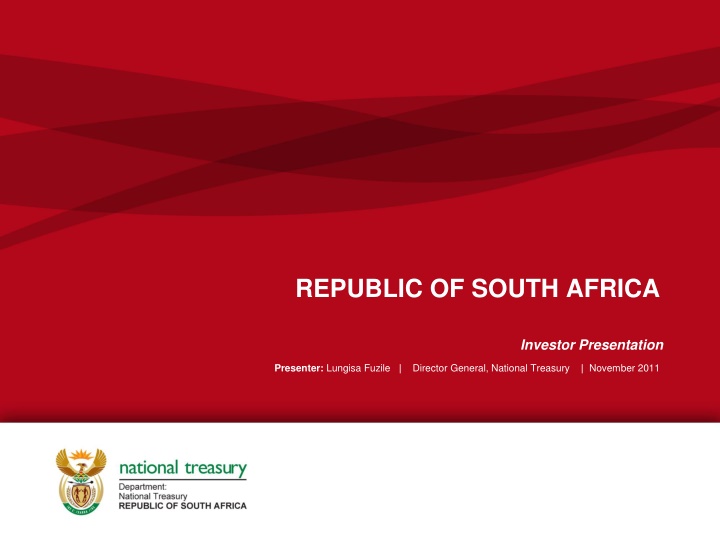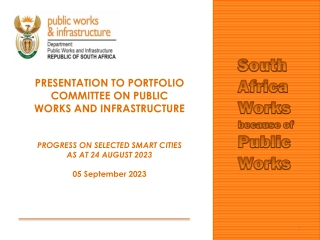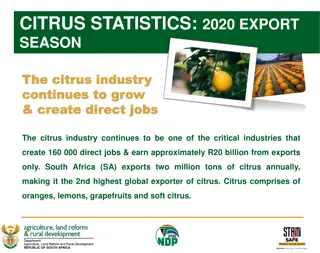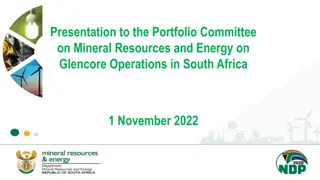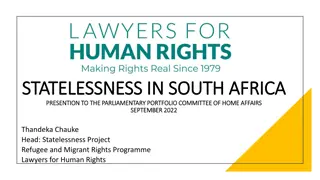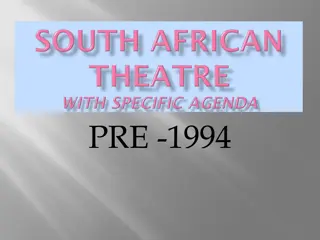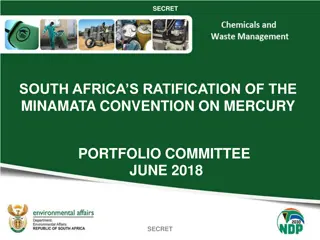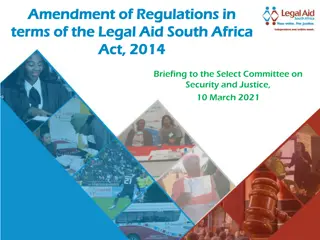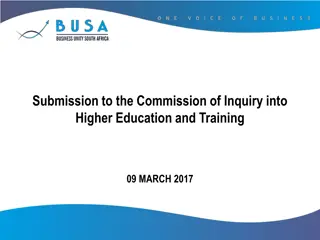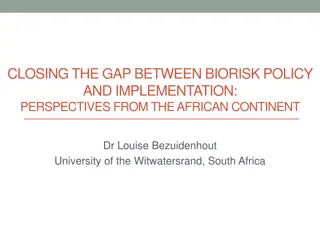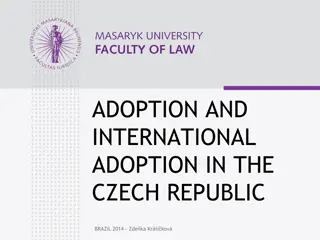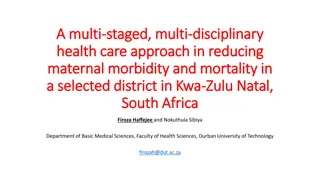REPUBLIC OF SOUTH AFRICA
The investor presentation by Lungisa Fuzile, Director General of National Treasury, provides key highlights on South Africa's economy, including recovery from slowdown, investment prospects, fiscal policy, and debt sustainability. The macro backdrop discusses global impacts, IMF growth projections, and the shift in world demand towards emerging market economies. Insights on South Africa's export trends and the balancing of world demand are also highlighted.
Download Presentation

Please find below an Image/Link to download the presentation.
The content on the website is provided AS IS for your information and personal use only. It may not be sold, licensed, or shared on other websites without obtaining consent from the author.If you encounter any issues during the download, it is possible that the publisher has removed the file from their server.
You are allowed to download the files provided on this website for personal or commercial use, subject to the condition that they are used lawfully. All files are the property of their respective owners.
The content on the website is provided AS IS for your information and personal use only. It may not be sold, licensed, or shared on other websites without obtaining consent from the author.
E N D
Presentation Transcript
REPUBLIC OF SOUTH AFRICA Investor Presentation Presenter: Lungisa Fuzile | Director General, National Treasury | November 2011 1 1
Key highlights Economy is recovering from Q2 slowdown, supported by: Favourable market backdrop for Emerging Markets Broadening in domestic demand Steadily improving investment prospects Accommodative monetary policy and counter-cyclical fiscal policy Fiscal finances on a sound footing Need for employment creation balanced with consolidation in expenditure Redirecting expenditure from current to infrastructure Debt and debt service ratios remain relatively low Debt sustainability a priority Borrowing requirement geared toward new growth path objectives External vulnerability reduced Current account deficit adequately financed Sustainable long-term policy solutions to limit current account funding risks Banking sector systemically sound 2 2
South Africa impacted by global developments IMF growth projections Global growth forecasts revised down from 4.4% to 4.0% Growth slowing in advanced economies High debt levels and borrowing costs High unemployment and weak housing markets Banking sector problems Brazil, China and India subject to inflationary and overheating pressures Forecast for South Africa growth to remain steady through 2013 GDP projections (%) Region / Country 2011 2012 2013 World 4.0 4.0 4.5 Advanced economies 1.6 1.9 2.4 US 1.5 1.8 2.5 Euro area 1.6 1.1 1.5 UK 1.1 1.6 2.4 Japan -0.5 2.3 2.0 Emerging markets and developing countries 6.4 6.1 6.5 Developing Asia 8.2 8.0 8.4 China 9.5 9.0 9.5 India 7.8 7.5 8.1 Middle East and North Africa 4.0 3.6 4.3 Sub-Saharan Africa 5.2 5.8 5.5 South Africa 3.1 3.4 4.1 Source: SA National Treasury 4 4
Rebalancing of world demand Structural shift in world demand underway as economic power shifts to Emerging Market economies Emerging Markets share in South Africa s export basket is rising: Share of exports to advanced economies declined to 51% in 2011 (64% in 2007) Exports to developing Asia increased to 27% in 2011 (15% in 2007) Africa absorbed 17% of SA exports over the past year Impact of slower growth in developed world on SA exports partially offset by stronger growth in Emerging Markets Emerging market household s final consumption expenditure as % of world expenditure 60 58 56 % 54 52 2000/2005 2006 2007 2008 2009 Source: World Bank Emerging Markets share of SA exports 40 30 % 20 10 0 China (incl. Hong Kong) EM (excl. China) Developed Markets (excl. Euro area) 2009 GIIPS Euro area (Excl. GIIPS) 1 2007 2008 2010 2011 1. GIIPS: Greece, Ireland, Italy, Portugal and Spain Source: The Department of Trade and Industry 5 5
The domestic economic outlook is positive but downside risks remain GDP recovery expected over medium term, underpinned by: Accommodative fiscal and monetary policies Public sector capital formation Improving private sector confidence Inflation anchored within target band in the medium and longer term Emerging Markets trade partner growth leading exports higher GDP growth revised down amid elevated global risks Slower developed market external demand growth to be countered by recovering domestic and EM demand momentum Strong demand from global trading partners for SA exports % y/y, smoothed 12 24 8 16 % y/y 4 8 0 0 -4 -8 -8 -16 -12 2000 -24 2002 Leading indicator of trading partners Export volumes incl. gold - lagged 3 quarters (RHS) 2004 2006 2008 2010 Source: SA National Treasury Macroeconomic growth forecasts, 2010 - 2014 2010 2011 2012 2013 2014 Calendar year Actual Estimate Forecast % change unless otherwise indicated Final household consumption 4.4 4.3 3.7 4.4 4.5 Gross fixed capital formation -3.7 2.9 4.5 5.7 6.3 Real GDP growth 2.8 3.1 3.4 4.1 4.3 GDP at current prices (R bn) 2,664.3 2,931.8 3,208.2 3,555.0 3,930.5 CPI inflation 4.3 5.0 5.4 5.6 5.4 Current account balance (% of GDP) -2.8 -3.4 -3.8 -4.0 -4.2 Source: SA National Treasury 7 7
Low debt ratios support demand Household debt service cost is low in comparison to historical levels Strong real wage gains have assisted households to deleverage Confidence has been supported by the recovery in real disposable income growth Real disposable income growth and debt service ratio 16 12 8 4 0 1998 2000 2002 2004 2006 2008 Debt service ratio 2010 Real disposable income (% y/y) Source: SARB Private sector credit ratio - Emerging Markets comparisons Relatively low debt ratios suggest scope for further growth in domestic demand Hong Kong China Malaysia Latvia Singapore % of GDP Israel South Africa Hungary Ukraine 77.4% Brazil India Russia 0 50 100 150 200 Source: World Bank 8 8
Healthy corporate profits supportive Corporate profitability and employment prospects have improved in tandem with the economic recovery Corporate balance sheets are healthy Growth in capital imports has picked up Real investment in productive capacity will foster higher economic activity Corporate profits1 and employment 25 6 4 20 % y/y 2 % y/y 15 - 10 (2) 5 (4) 0 (6) 2004 Gross operating surplus (LHS) Non-farm formal sector employment (RHS) 1.Provided by gross operating surplus Source: Stats SA 2002 2006 2008 2010 Progress in fixed capital formation underway 50 % y/y (3mma) 20 15 % y/y (3mma) 30 10 -5 10 (10) (5) (10) (30) (15) (50) 2000 (20) 2002 2004 Real capital goods imports (LHS) Real fixed capital formation (RHS) 2006 2008 2010 1 1.Nominal imports deflated by trade-weighted exchange rate Source: Department of trade and Industry (DTI), SARB 9 9
3. Public Finance 10 10
New growth cycle encourages fiscal consolidation Fiscal discipline is critical to create scope for counter-cyclical policy Public infrastructure programmes of more than R800bn will maintain economic stimulus A stabilisation of non-interest spending and higher revenue reduces the primary budget deficit from -4.3% in 2009/10 to -0.5% of GDP in 2014/15 Supportive fiscal policy matched with debt and spending management Focus on changing the composition of spending and addressing inefficiency and waste Consolidated government fiscal framework, 2010/11 2014/15 2010/11 Actual 758.4 27.6 885.8 32.2 -127.4 -4.6 2011/12 Estimate 814.2 27.3 978.8 32.9 -164.6 -5.5 2012/13 2013/14 Medium-term estimates 890.0 994.5 27.0 27.3 1,062.3 1,157.4 32.2 31.8 -172.3 -162.9 -5.2 -4.5 2014/15 R bn Revenue % of GDP Expenditure % of GDP Budget balance % of GDP 1,113.0 27.7 1,247.0 31.0 -134.1 -3.3 Source: SA National Treasury Primary budget deficit to narrow significantly over the medium term 1,400 5 1,200 3 % of GDP 1,000 R bn 1 800 600 -1 400 -3 200 0 -5 2007/08 Revenue 2008/09 2009/10 Expenditure 2010/11 2011/12 2012/13 Primary budget balance (RHS) 2013/14 2014/15 Source: SA National Treasury 11 11
Sustained infrastructure investment spending is critical A rebalancing of expenditure towards investment, job creation and socio- economic priorities (education and health) Focus on investment spending to increase productive capacity Emphasis on economic infrastructure and network industries to reduce bottlenecks and lower the cost of doing business Investment in electricity generation capacity for reliable energy to support faster growth Transport infrastructure accounts for R226bn over the MTEF Public sector infrastructure expenditure over the MTEF Social services 12% Justice and protection services 2% Other 2% Economic Services 84% Breakdown of Economic services expenditure Water and sanitation 9% Other economic services 14% Energy 44% Transport and logistics 33% Source: SA National Treasury 12 12
Public sector borrowing requirement set to moderate over medium term The public sector borrowing requirement is projected to fall from 8.1% as a percentage of GDP in 2011/12 to 5.1% by 2014/15 SOEs ability to collect internally generated funds has improved, putting less pressure on debt finance The rising borrowing requirement of non-financial public enterprises is in line with the requirements of the New Growth Path The main budget balance worsens on account of the automatic adjustment of revenue to the weaker economic environment. This should, however, be temporary Public sector borrowing requirement Forecast to decrease from 8.1% to 5.1% 10 8 1.9 2.5 2.4 6 2.1 1.8 % of GDP 1.6 4 7.0 2.7 5.6 5.4 4.7 4.7 2 3.5 1.7 1.6 0 -1.5 -2 2007/08 2008/09 2009/10 2010/11 2011/12 f 2012/13 f 2013/14 f 2014/15 f General government Non-financial public enterprises Source: SA National Treasury 13 13
Public debt sustainable over medium term The counter-cyclical fiscal stance led to increased borrowing to meet expenditure commitments Government Guarantees for SOEs have increased since 2008/09 to provide access to cost-effective borrowing Net loan debt forecasted to peak at around 40% of GDP in 2014/15 From 2013/14 onward, new government borrowing will finance investment spending to strengthen the country s asset base Net loan debt stabilises at 40% of GDP As at 31 March 2008/09 2009/10 2010/11 2011/12 2012/13 2013/14 2014/15 R billion Actual Estimate Medium-term estimates Domestic Gross loan debt1 529.7 705.5 892.7 1,069.6 1,249.0 1,432.6 1,599.9 Cash balances -101.3 -106.6 -111.4 -114.8 -107.2 -102.2 -102.2 Net loan debt2 428.4 598.9 781.3 954.8 1,141.8 1,330.4 1,497.7 Foreign Gross loan debt1 97.3 99.5 97.9 101.7 105.4 104.0 104.3 Cash balances - -25.2 -62.1 -50.4 -35.6 -18.3 -4.3 Net loan debt2 97.3 74.3 35.8 51.3 69.8 85.7 100.0 Total gross loan debt 627.0 805.0 990.6 1,171.3 1,354.4 1,536.6 1,704.2 Total net loan debt 525.7 673.2 817.1 1,006.1 1,211.6 1,416.1 1,597.7 As percentage of GDP: Total gross loan debt 27.1 33.0 36.0 39.3 41.1 42.2 42.4 Total net loan debt 22.7 27.6 29.7 33.8 36.7 38.9 39.7 1. Forward estimates are based on National Treasury s projections of exchange and inflation rates 2. Net loan debt is calculated with due account of the bank balances of the National Revenue Fund Source: SA National Treasury 14 14
Debt service costs stabilise Debt service costs as a share of GDP is expected to stabilise by 2014/15 due to: Moderation in spending growth Recovery in tax revenue Majority of debt service costs are denominated in local currency - as such reduced exposure to currency fluctuations Debt service cost as a % of revenue, expenditure and GDP 26 6 24 % of revenue and expenditure 22 5 20 % of GDP 18 4 16 14 3 12 10 2 8 6 1 1998/99 2000/01 2002/03 2004/05 2006/07 2008/09 2010/11 2012/13 2014/15 % of revenue % of expenditure % of GDP Source: SA National Treasury 15 15
Debt metrics highlight South Africa as relatively low risk The government debt-to-GDP ratio remains low relative to that of the developed world and compares favourably to Emerging Markets peers The budget framework endeavours to keep the debt- service ratio low to avoid crowding out other expenditure South Africa s debt service-to- GDP ratio also compares favourably to Developed Markets and Emerging Markets countries Gross debt-to-GDP comparison (2010) 240 % of GDP 160 80 34% 0 UK US Italy China Mexico India Turkey Japan Canada Argentina France Australia Brazil Germany South Africa Source: IMF World Economic Outlook, September 2011 Debt service ratio comparison (2010) 18 15 % of GDP 12 9 6 2.43% 3 0 Source: Global Insight, SA National Treasury 16 16
4. Monetary Policy 17 17
Monetary policy fairly accommodative South Africa s repo rate, at 5.5% is at a 30-year low. These rates are seen to be appropriate to support the recovery and consistent with the inflation target Despite the low policy rate, nominal rates are still well above the zero bound. As a result, policy makers have scope to provide further stimulus if necessary Real rates are not at extremes in a global context, but are accommodative in a local context Nominal policy rates (%) US UK Canada Euro Area New Zealand Australia South Africa 5.50% Turkey China India Russia Brazil 0 2 4 6 8 10 12 Source: Bloomberg Real policy rates (%) UK US Canada New Zealand Euro Area India Turkey -0.20% South Africa China Australia Russia Brazil -5 -3 -1 1 3 5 Source: Bloomberg, Reuters Ecowin, RMB FICC Research 18 18
Muted core inflation affords accommodative policy Currency appreciation and a deceleration in global price pressures dragged targeted inflation below the mid-point of the 3-6% target band during 2010/11 Rising global commodity price inflation during 1H11 now evident in rising food and petrol inflation Core inflation is well-contained 15 12 % y/y 9 6 3 0 2005 Core inflation (excl. food, NAB, petrol and energy) Target inflation Source: Stats SA. Note: NAB = non-alcoholic beverages 2003 2004 2006 2007 2008 2009 2010 2011 Monetary policy reacts to the second- round effects on inflation of supply side shocks Marginal temporary breach of the target expected between 4Q11 to 3Q12 Core inflation is still well-contained and is forecast to remain relatively benign Medium and longer term inflation still seen within the target range Monetary policy responsive to core inflation 6 4 2 0 -2 % -4 -6 -8 -10 2000 2001 2002 Change in core inflation 2003 2004 2005 2006 2007 2008 2009 Change in repo rate 2010 2011 Source: SARB, Stats SA 19 19 19 19
External vulnerability reduced by positive balance of payments position Structural deficit remains the key contributor to the current account deficit Net services and income payments to the world account for 90% of the current account deficit Structural account deficit 3 0 % of GDP (saa) -3 -6 -9 1Q06 3Q06 1Q07 Trade Net transfers 3Q07 1Q08 3Q08 Services Current account 1Q09 3Q09 1Q10 3Q10 Incomes 1Q11 Source: SARB Portfolio inflows continue to be the primary funding source of the current account deficit Net capital inflows reduces balance of payments risks 12 8 % of GDP 4 0 -4 2000 2001 Current account deficit Balance of payments surplus 2002 2003 2004 2005 2006 2007 Financial account surplus 2008 2009 2010 2011 1 1. Including unrecorded transactions Source: I-Net Bridge 21 21
South Africa is affected both directly and indirectly by the global turmoil Uncertainty around the European sovereign debt crisis causes volatility in financial markets Failure to resolve the debt crisis will result in global contagion Direct impact on South Africa economy: Downturn and weak revenue performance from global recession Volatility of the exchange rate Weaker global demand for South African exports Global investment uncertainty Volatility in commodity prices, including food and oil Indirect impact of turmoil on South Africa economy: Impact on equity-linked pensions funds Turmoil and sovereign debt downgrades could impact international funding conditions for South Africa and SOEs 22 22
Ample banking system liquidity South African banking system has weathered the financial crisis well Top four South African banks represent 85% of market share Banks are comfortably exceeding the minimum capital adequacy requirements of 9.75% The current banking sector Tier 1 capital to risk-weighted assets ratio is over 11%, exceeding the target Basel III requirements for 2018 South Africa ranked 6th out of 139 countries in terms of soundness of banks (World Economic Forum Executive Opinion Survey) Capital adequacy 18 Minimum capital adequacy requirements of 9.75% 16 14 12 10 % 8 6 4 2 0 Dec-08 Dec-09 Jun-10 Nedbank Dec-10 Jun-11 Absa FirstRand Limited Standard Bank Source: company data Funding structure of SA banks Professional/wholesale deposits Household deposits Corporate sector deposits Government, local government & public enterprises deposits Interbank and intragroup deposits Other borrowed funds Subordinated debt Non-resident deposits Foreign currency funding 30.5% 20.5% 19.7% 8.6% 6.6% 4.9% 4.0% 2.7% 2.3% Source: SARB, June 2010 24 24
Banking system remains systemically sound Banks account for 33% of the total local primary market issuance over the last five years Cost of bank funding in the local market increased during the crisis, but spreads have contracted significantly Asset quality has seen significant improvements since 2010 Robust primary issuance volumes in the local capital markets 120 100 80 R bn 60 40 20 0 2006 Banks / Financials 2007 2008 2009 2010 2011 Corporates Municipal SOEs Securitisations Source: JSE 25 25
7. Conclusion 26 26
Concluding thoughts The macroeconomic landscape has moderated, requiring continued policy accommodation Continued focus on economic transformation through: job creation, economic support package and expansion in infrastructure investment and spending on social developments Stimulatory fiscal and monetary policy are cushioning South Africa from the global slowdown, and employment should continue to expand Prudent fiscal management and automatic stabilisers ensure that the fiscal position should return to pre-crisis levels without requiring meaningful fiscal austerity Low debt to GDP levels are structural tailwinds and total external debt remains low and manageable The banking system remains on a sound footing 27 27
